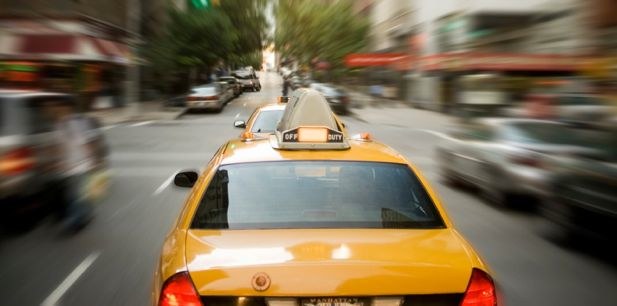How to Taxi Like a New Yorker in New York City
How To: Hailing a cab in the Big Apple takes technique. Riding like a local requires panache. Cab driver Layne Mosler explains.
06.21.10 | 10:39 AM ET
 iStockPhoto
iStockPhotoThe situation: You’re in New York City and you need a cab. Dozens of yellow taxis are zipping past, but you can’t seem to flag one down. Or maybe you have no idea how to pass yourself off as a local once you’ve succeeded. You need help.
I’ve been a licensed New York City cabbie for six months, and I’ve learned a few things. If you’re visiting the Big Apple and want to make like a New Yorker in one of the city’s 13,000 taxis, read on.
Hail with authority: A cab driver is looking in four directions and three mirrors, keeping other maniacal drivers off her tail, anticipating untelegraphed lane changes and scanning the streets for passengers at the same time. If you barely raise your hand, we can’t see you or cross four lanes of traffic in time to pick you up.
To properly hail a cab, step off the curb a few paces into the street, being careful to watch for oncoming traffic. Then thrust your right or left arm out toward the street, until it’s completely outstretched, at a 45 degree angle to the sky. Your palm should be facing down, your fingers extended. Don’t worry if you don’t see any oncoming cabs—when you salute the street this way, we can see you from hundreds of yards away. If you’re especially desperate, you can move your straight arm up and down. To see someone hail like a pro, head over to Central Park West and check out the doormen: They wave their arms as if they’re on a desert island begging an airplane to land—and they get us to pull over every time.
Consider the time of day: Day drivers usually return their cabs to the garage between 3 p.m. and 5 p.m., and night drivers do the same between 4 a.m. and 5 a.m. You might have a hard time finding a cab during these changeover windows, so if you have to make a trip at those hours, know that it may take longer than usual to find a ride—especially if you’re heading a long distance, such as to the airport. An off-duty driver may be willing to take you where you need to go if you’re heading in the direction of his garage, but this can depend on his mood after a 10- to 12-hour shift.
The cabbie color palette: Yellow cab? Gypsy cab? Black car? Yellow cabs are the only taxis legally authorized to pick up street hails, but livery cabs (aka gypsy cabs or black cars) often infringe on our territory, even though they’re supposed to restrict their business to passengers who call them (or their dispatching companies) directly. What’s a passenger to do?
Consider this: Unlike livery drivers, yellow cabbies have to pass a rigorous geography exam and an English test. Plus, every yellow cab ride is regulated by the meter and tracked by the Taxi & Limousine Commission’s central GPS, and we accept credit cards. However, if you happen to be north of Central Park or in the outer boroughs—where yellow taxis rarely roam—feel free to hop in one of those black cars. If you’re anywhere between Central Park and southern Manhattan, a yellow cab is your safest bet.
When you’re in the back seat: Assume we speak your language. Several weeks ago three transvestites climbed into my taxi and launched into a chorus of Caribbean Spanish they assumed I didn’t understand. I listened closely as they described the fetishes of the clients they’d just serviced (“You wouldn’t believe the younger one! He wanted me to brush against his…”). They’d obviously forgotten that this is New York: Many taxi drivers speak at least two languages, and some of us speak five or more. So keep in mind that we probably understand what you’re saying.
Resist the urge to hit on us (unless you’re Viggo Mortensen and you’re riding in my cab): My colleagues and I often meet passengers who assume we’re willing to kiss them or go to breakfast (or beyond) while we’re on duty. Yes, hacking is a job that attracts a fair number of free spirits who can’t abide a traditional boss, but that doesn’t mean we’re willing or able to jump into a tryst. Especially if there’s no taxi stand nearby. Where would we park?
Spill it: Like bartenders and hairdressers before us, many cabbies have mastered the art of listening while remaining focused on the task at hand. We also know how unlikely it is that we’ll ever meet again. So go ahead and share your secrets. Even if we happen to pick you up a second time, you can depend on our discretion.
Anticipate the drop-off: If you’re paying in cash and we’re dropping you off someplace like Times Square or Grand Central Station, try to get your money ready ahead of time (unless you don’t mind being the object of honking as you’ve never heard it before).
Tipping 101: As long as your driver hasn’t endangered your life or the lives of others over the course of your journey, a 15-20 percent is standard for a taxi ride in New York. If you think we deserve more, we’ll naturally appreciate that. Cabbies pay anywhere between $150 to $200 to lease a car for the day, spend half to two-thirds of our shifts recouping that cost, and usually take home between $50 and 100 for 10 to 12 hours of driving. A nice tip can make our day, although a passenger with an interesting story to tell can give us just as much of a thrill.![]()